The Surprising History of Satay in Singapore, Malaysia & Indonesia |Tony Johor Kaki Travels for Food · Heritage · Culture · Diplomacy
johorkaki.blogspot.com
Satay (known as sate in Indonesia) is a popular BBQ dish found everywhere in Indonesia, Singapore and Malaysia.
Satay is small pieces of spice marinated meat (usually lamb, beef, chicken) skewered with a thin wooden stick cooked by grilling over a trough of open charcoal fire.
Since I was a boy, I am thrilled by the sight of leaping orange flames made by grease dripping onto the red hot embers. The aroma of hissing smoke from spiced grilled meat fill the air around the satay stall. You can see a satay stall from a mile away by its cloud of white smoke, smell it when you are half way there.
Satay is eaten with a thick dipping sauce. In Malaysia and Singapore it is often a sweet nutty savoury subtly spicy peanut and spice sauce. In Indonesia, it is often more savoury and spicy - they spike the peanut sauce with dark soy sauce and cut chili pepper. In Singapore, Hainanese Chinese scoop in a dollop of pineapple puree to give the peanut sauce a bit of citrusy zest. There are many local variations.
There are also many variations in the skewered meat depending on region and community - there's the usual lamb, beef and chicken. Then there's fish, rabbit, pork, offal (intestines, chicken heart, chicken gizzard, bishop's nose etc) and others I shall not mention.
So, where do satay originally come from?
This could be the great grandfather of satay.
This ancient Greek terracotta BBQ set dates back 1,700 years before Christ i.e. nearly 4,000 years ago Looking at the size of the handle, this might be the proto-table top BBQ set of the world
The origins of grilled skewered meat is usually attributed to ancient Mesopotamia (today's Iraq) and spread across the Middle East. The conquering Afghans brought the dish to India in the 10th century.
The Mongols reached the Middle East around 1250 and brought the dish to China when they ruled the Middle Kingdom from 1271–1368 (as the Yuan dynasty). The grilled skewered meat dish arrived in Indonesia in the 1400s through Arabs, Indians, and possibly Chinese too.
This might explain why we have 3 versions of the origin of sate in Indonesia (which wouldn't be surprising once we think of Indonesia as the crossroad of east and west).
One theory suggests that the Indonesian name sate came from the ancient Tamil word for flesh, "catai". Indian influence in Indonesia dates back to the first centuries A.D.
The Buddhist Srivijaya Empire ruled the Malay peninsula, Sumatra and most of Java from 650 - 1377. Its successor, the Hindu-Buddhist Majapahit Empire which ruled from 1293 - 1517 controlled the entire Indonesian archipelago and Malay peninsula at its peak.
According to this theory, when Gujarati traders from India brought their seekh kabab dish to Indonesia, the locals adapted this dish and called it "sate". But, this theory doesn't address how or why the metal skewer was replaced by coconut leaf stem or bamboo - which is one of the defining features of sate.
Another theory linked the name sate to a bamboo craftsman named Satah.
Satah was a disciple of Malik Ibrahim who was one of nine saints (Wali Songo) who first brought Islam to Indonesia. Malik Ibrahim died in 1419 in Gresik (in Java).
During Adha or the Islamic Day of Sacrifice, a lamb, cow or buffalo is offered. Satah would make Arabian style kebabs with small pieces of meat skewered with a thin piece of bamboo grilled over charcoal embers. Satah's creation was very well received and the dish became known as "sate".
The earliest Chinese immigration to Indonesia was in the 1300s, but the numbers were greatest during the mid 1800s to early 1900s. At that time, the Qing dynasty was collapsing and many Chinese from southern China (Hokkien, Cantonese, Hakka) were fleeing wars and famine.
However, there are no records of where, how or when Chinese style kebabs arrived in Indonesia. Also, back in China, kebabs 烤肉串 are more favoured by northern Chinese than southern Chinese.
One theory claims that the name sate or 沙爹 in Chinese came from the Hokkien phrase 三块 which means "three pieces" referring to the 3 pieces of meat in the wooden skewer.
This theory sounds intuitively attractive but there is no evidence on where this started in Java. Furthermore, traditionally in Java, satay had 4 pieces of meat.
Nevertheless, Chinese style satay do often have just 3 pieces of meat (some say because the number 4 is considered inauspicious as it sounds like the Chinese word for death).
One of the defining features that distinguishes Indonesian/ Malaysian/ Singapore satay from Arabian/ Indian/ Chinese kebabs is the grainy peanut and spice (coriander seed, cumin, turmeric etc) sauce. One theory suggests that the name satay came from the Chinese name for the peanut sauce 沙爹 which sounds like "sah ti aye".
People move around between Java, Sumatra and the Malay Peninsula since time immemorial. Javanese migration to Singapore peaked around the late 1800s to 1920s to work as bonded labourers in plantations. They brought their sate with them, selling them in two baskets on a bamboo pole slung across the shoulder.
In one basket, the peanut sauce and small serving bowls. In the other, a small charcoal stove and satay.
The skewered meat were grilled on the spot and customers sat on little stools around the stall to eat.
Sate became extremely popular among all the communities. In Singapore, it became known by their Malay name, satay.
Chinese satay offers options of pork meat & fat, pork intestines, pork liver and chicken.
The most famous place to have satay in Singapore was at the "Satay Club at the Esplanade". It had 28 food stalls, mostly selling satay.
The "Satay Club at the Esplanade" was the satay and dating hotspot of Singapore until it was demolished in 1995 for redevelopment into the Esplanade - Theatres at the Bay complex. The "Satay Club" was located on Queen Elizabeth Walk (a narrow breezy tree lined promenade) between the Padang (big field) and the sea.
There were attempts to bring back the Satay Club in other locations but did not last long as the ambiance and atmosphere at the old Elizabeth Walk cannot be replicated.
Today, satay is sold everywhere in Singapore. Most hawker centres have at least one satay stall.
Where do you get your satay fix in Singapore and Johor?
johorkaki.blogspot.com
Satay (known as sate in Indonesia) is a popular BBQ dish found everywhere in Indonesia, Singapore and Malaysia.
Satay is small pieces of spice marinated meat (usually lamb, beef, chicken) skewered with a thin wooden stick cooked by grilling over a trough of open charcoal fire.
Since I was a boy, I am thrilled by the sight of leaping orange flames made by grease dripping onto the red hot embers. The aroma of hissing smoke from spiced grilled meat fill the air around the satay stall. You can see a satay stall from a mile away by its cloud of white smoke, smell it when you are half way there.
Satay is eaten with a thick dipping sauce. In Malaysia and Singapore it is often a sweet nutty savoury subtly spicy peanut and spice sauce. In Indonesia, it is often more savoury and spicy - they spike the peanut sauce with dark soy sauce and cut chili pepper. In Singapore, Hainanese Chinese scoop in a dollop of pineapple puree to give the peanut sauce a bit of citrusy zest. There are many local variations.
There are also many variations in the skewered meat depending on region and community - there's the usual lamb, beef and chicken. Then there's fish, rabbit, pork, offal (intestines, chicken heart, chicken gizzard, bishop's nose etc) and others I shall not mention.
So, where do satay originally come from?
This could be the great grandfather of satay.
This ancient Greek terracotta BBQ set dates back 1,700 years before Christ i.e. nearly 4,000 years ago Looking at the size of the handle, this might be the proto-table top BBQ set of the world
The origins of grilled skewered meat is usually attributed to ancient Mesopotamia (today's Iraq) and spread across the Middle East. The conquering Afghans brought the dish to India in the 10th century.
The Mongols reached the Middle East around 1250 and brought the dish to China when they ruled the Middle Kingdom from 1271–1368 (as the Yuan dynasty). The grilled skewered meat dish arrived in Indonesia in the 1400s through Arabs, Indians, and possibly Chinese too.
This might explain why we have 3 versions of the origin of sate in Indonesia (which wouldn't be surprising once we think of Indonesia as the crossroad of east and west).
One theory suggests that the Indonesian name sate came from the ancient Tamil word for flesh, "catai". Indian influence in Indonesia dates back to the first centuries A.D.
The Buddhist Srivijaya Empire ruled the Malay peninsula, Sumatra and most of Java from 650 - 1377. Its successor, the Hindu-Buddhist Majapahit Empire which ruled from 1293 - 1517 controlled the entire Indonesian archipelago and Malay peninsula at its peak.
According to this theory, when Gujarati traders from India brought their seekh kabab dish to Indonesia, the locals adapted this dish and called it "sate". But, this theory doesn't address how or why the metal skewer was replaced by coconut leaf stem or bamboo - which is one of the defining features of sate.
Another theory linked the name sate to a bamboo craftsman named Satah.
Satah was a disciple of Malik Ibrahim who was one of nine saints (Wali Songo) who first brought Islam to Indonesia. Malik Ibrahim died in 1419 in Gresik (in Java).
During Adha or the Islamic Day of Sacrifice, a lamb, cow or buffalo is offered. Satah would make Arabian style kebabs with small pieces of meat skewered with a thin piece of bamboo grilled over charcoal embers. Satah's creation was very well received and the dish became known as "sate".
The earliest Chinese immigration to Indonesia was in the 1300s, but the numbers were greatest during the mid 1800s to early 1900s. At that time, the Qing dynasty was collapsing and many Chinese from southern China (Hokkien, Cantonese, Hakka) were fleeing wars and famine.
However, there are no records of where, how or when Chinese style kebabs arrived in Indonesia. Also, back in China, kebabs 烤肉串 are more favoured by northern Chinese than southern Chinese.
One theory claims that the name sate or 沙爹 in Chinese came from the Hokkien phrase 三块 which means "three pieces" referring to the 3 pieces of meat in the wooden skewer.
This theory sounds intuitively attractive but there is no evidence on where this started in Java. Furthermore, traditionally in Java, satay had 4 pieces of meat.
Nevertheless, Chinese style satay do often have just 3 pieces of meat (some say because the number 4 is considered inauspicious as it sounds like the Chinese word for death).
One of the defining features that distinguishes Indonesian/ Malaysian/ Singapore satay from Arabian/ Indian/ Chinese kebabs is the grainy peanut and spice (coriander seed, cumin, turmeric etc) sauce. One theory suggests that the name satay came from the Chinese name for the peanut sauce 沙爹 which sounds like "sah ti aye".
 |
| Javanese satay man in Singapore 1906. Image credit: National Archives of Singapore |
People move around between Java, Sumatra and the Malay Peninsula since time immemorial. Javanese migration to Singapore peaked around the late 1800s to 1920s to work as bonded labourers in plantations. They brought their sate with them, selling them in two baskets on a bamboo pole slung across the shoulder.
 |
| Satay man in Singapore 1907. Image credit: National Archives of Singapore |
In one basket, the peanut sauce and small serving bowls. In the other, a small charcoal stove and satay.
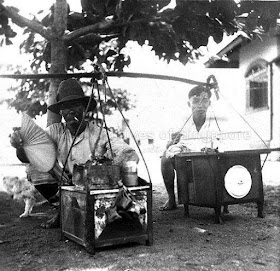 |
| Satay man with customer in Singapore 1930s. Image credit: National Archives of Singapore |
The skewered meat were grilled on the spot and customers sat on little stools around the stall to eat.
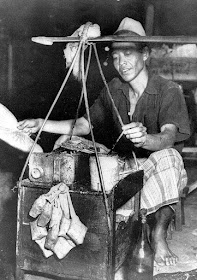 |
| Satay man & kutuput in Singapore 1930s. Image credit: National Archives of Singapore |
Sate became extremely popular among all the communities. In Singapore, it became known by their Malay name, satay.
 |
| Image credit: National Archives of Singapore |
Chinese satay offers options of pork meat & fat, pork intestines, pork liver and chicken.
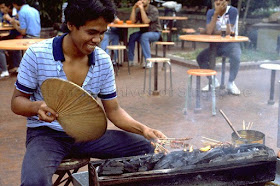 |
| Singapore Satay Club 1985. Image credit: National Archives of Singapore |
The most famous place to have satay in Singapore was at the "Satay Club at the Esplanade". It had 28 food stalls, mostly selling satay.
 |
| Image credit: National Archives of Singapore |
The "Satay Club at the Esplanade" was the satay and dating hotspot of Singapore until it was demolished in 1995 for redevelopment into the Esplanade - Theatres at the Bay complex. The "Satay Club" was located on Queen Elizabeth Walk (a narrow breezy tree lined promenade) between the Padang (big field) and the sea.
There were attempts to bring back the Satay Club in other locations but did not last long as the ambiance and atmosphere at the old Elizabeth Walk cannot be replicated.
Today, satay is sold everywhere in Singapore. Most hawker centres have at least one satay stall.
Where do you get your satay fix in Singapore and Johor?

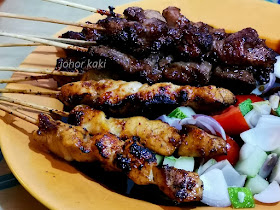
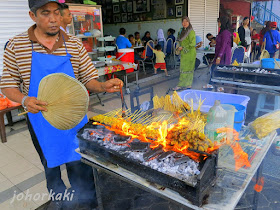
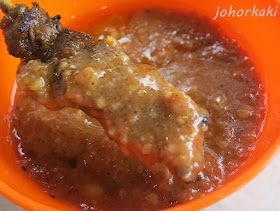
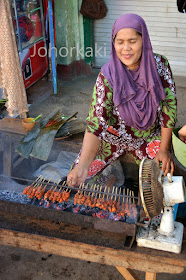





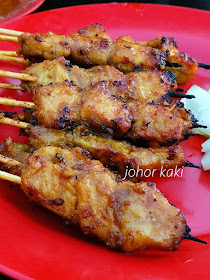
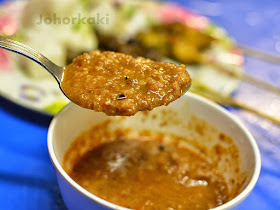
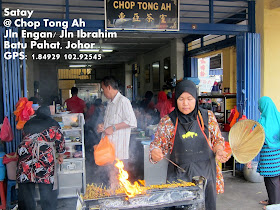



 it should be lerine....
it should be lerine....